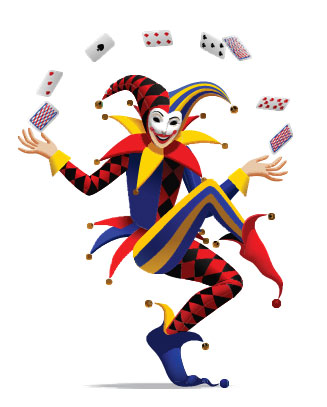PLAYING THE FOOL
In poker, trickery and deceit are powerful tools
By Jack Clayton
 Football season is in full swing, with college rivalry games taking place this month. That means intense action, bragging rights at stake, as well as state and conference pride on the line. It’s also a time when college coaches often put in trick plays for big games against heated rivals. The purpose being to catch the opponent off guard, while trying to pick up extra yards and points.
Football season is in full swing, with college rivalry games taking place this month. That means intense action, bragging rights at stake, as well as state and conference pride on the line. It’s also a time when college coaches often put in trick plays for big games against heated rivals. The purpose being to catch the opponent off guard, while trying to pick up extra yards and points.
That said, trick plays can backfire, too. For example, teams often try the old standby, the “flea flicker”, a deceptive play that starts as a run, then quickly turns into a pass. However, a prepared and alert team can quickly sniff this out and shut it down hard. The lesson doesn’t just apply to football, either. At the poker tables, the smart, well-disciplined players will get fooled the least.
Poker players are actors, trying to put on a face to make their opponent think one thing to throw them off track. Understand the techniques involved when one poker play is trying to fool you. There are times when an average poker player tries hard not to look like a fish – too hard, as they don’t understand the subtleties. Advanced players can sense that they may not be giving out the true strength of their hand. Most players try and disguise their actions, so be cautious if one player suddenly begins shaking their head, fidgeting, boasting about how unlucky they are, or openly looking sad-eyed. Are they on the level? Or trying to throw you a curve? The more you play and observe, the better you can sense the realism from the would-be actors.
Are they trying to trap you? Sure. It’s all part of the mental cat-and-mouse side of poker, which is so enthralling and challenging. That’s why it’s important to understand what opponents are trying to do, and for you to fire back at them. For instance, change gears during a game. Acting contrary to your image shouldn’t be a one-time thing. Start playing loose, for example, when it’s clear after you’ve developed a tight image and vice-versa. After a couple of gear shifts your opponents won’t know who you are – and that’s a good thing. The more balls you toss in the air, the less your opponents will be able to detect your patterns.
Have a game plan when you sit down. If you’re generally a loose player, spend a little time folding to establish a tight image before loosening up. Your speculative hands will get paid because few will suspect your hand, so your bluffs will get more respect. If you’re a tight player, start off with some plays contrary to this, such as posting your blind out of turn and raise your first three hands regardless of what they are. Get caught with trash once or twice and then tighten up to keep opponents confused.
You don’t have to discover these acting tips on your own, either. Watch the pros on YouTube, which host many videos and poker bloggers. Cable television brings you coverage of hands played by professional players all around the world, with advice from experts. Watch the hands played, but also listen care- fully to the commentary and absorb it. Then try implementing those tips and strategy into your own play at the poker tables.
Also be aware of one other thing: Some players are better and more experienced than you. Astute players will pick up on how you play certain hands. Here’s how you can use that to your advantage. If you’ve bluffed several hands and your opponents were able to see some of them, when you do get a great hand you can use the same behavioral playing pattern. In their minds, you’re bluffing again. In reality, you’ve got them right where you want them, with a great hand and everyone thinking that you’re bluffing. That’s when the pot grows – along with your confidence as you rake it in.


